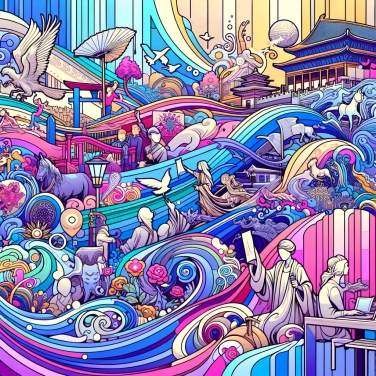Ancient civilizations used to build complex irrigation canals to increase agricultural yields in arid or semi-arid areas, thereby ensuring better food security for their population.

To put it simply, agriculture was vital for feeding an entire population. But rain didn't always fall at the right time or in the right place. So, to avoid famine, ancient civilizations created smart networks of canals that allowed them to precisely control water based on needs and seasons. As a result, they could easily irrigate their farmland, increase yields, and produce in a regular and stable manner. Thanks to the canals, they also stored water during dry periods, which was quite an ingenious system. By controlling water with these complex canals, they optimized a valuable resource and significantly improved their daily lives.
The ancients understood that channeling water could prevent significant damage. During seasonal floods, rivers often overflowed, threatening farms and villages. By building complex networks of canals, they created a kind of relief valve: excess water could flow away, be distributed, or stored in basins. This not only limited the risks of sudden flooding but also helped reduce soil erosion, thereby preventing the rapid depletion of arable land. In short, it was a smart way to work with nature instead of suffering from its excesses.
In many ancient civilizations such as Egypt, Mesopotamia, or China, canals served both for irrigation and transportation. Quite practical, as transporting heavy goods—grains, stones, wood—by boat was much faster, more economical, and less exhausting than by donkey or on foot. These water networks directly connected fields, markets, cities, and even distant towns. The result: enhanced, smoother trade, a more dynamic economy, and of course, an easier spread of goods, ideas, and know-how. In short, the real highway of the time.
Building sophisticated canals was also a very effective tool for asserting the power of leaders. By controlling the distribution of water, these leaders could decide which lands would be fertile or not, thereby strengthening their authority and making themselves indispensable in the eyes of the population. The organization required to maintain and dig these gigantic infrastructures also contributed to creating social cohesion: everyone had to work together, cooperate, and adhere to certain common rules. Canals thus became not only a concrete proof of power but also an effective means of bringing the community together around a strong collective project. Some leaders even took advantage of these hydraulic achievements to mark their territory and clearly demonstrate their ability to manage, organize, and protect their people.
In many ancient civilizations, canals were not just practical, but often laden with religious symbolism. For the Egyptians, for example, the Nile was seen as the divine incarnation offering life and abundance, and their canals were perceived as a sort of sacred extension of this river. In Mesopotamia, water was associated with several important deities, and maintaining the canals became almost a religious act, a way to be in good standing with the gods to obtain their favor. Among the Aztecs as well, water represented a central element in their beliefs, and their canals were closely linked to ceremonies dedicated to their agricultural and aquatic gods. In short, canals and religion went hand in hand, confirming how water was perceived as precious, mysterious, and divine in the ancient collective imagination.
In Peru, the Nazca civilization built an astonishing underground network called 'puquios', consisting of spiral canals that allowed them to tap into groundwater despite an extremely arid climate.
The nilometer, invented by the ancient Egyptians over 3,000 years ago, was used to accurately measure the height of the Nile in order to anticipate floods and better organize agricultural harvests.
The irrigation system of the Hanging Gardens of Babylon, one of the Seven Wonders of the Ancient World, was so advanced that its exact mechanisms remain a mystery to archaeologists today.
In ancient China, the Dujiangyan irrigation system, constructed in 256 BC, is still functioning today, providing water to thousands of hectares of farmland in Sichuan province.
Although very advanced technologically, some ancient civilizations have disappeared due to environmental factors, such as drastic climate changes, persistent droughts, or internal socio-economic factors.
Yes, some techniques such as gravity irrigation, qanats, or terracing are still used today in many parts of the world, sometimes enhanced with modern technologies.
Ancient civilizations often associated water management with deities or religious rites, viewing canals as a divine blessing to ensure fertility and agricultural abundance, thereby giving them a strong symbolic dimension.
Among the most well-known examples are the canals of Mesopotamia, the qanats in Persia, the Inca agricultural terraces in the Andes, and the sophisticated irrigation systems of the Egyptian civilization centered around the Nile.
The effective management of hydraulic resources allowed leaders to demonstrate their organizational abilities, control the distribution of vital resources, and thus strengthen their authority by ensuring food security and social stability for the population.

No one has answered this quiz yet, be the first!' :-)
Question 1/5